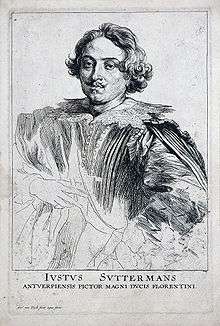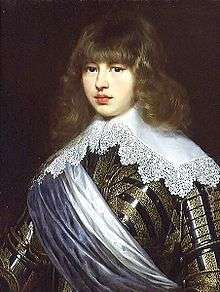Justus Sustermans
| Justus Sustermans | |
|---|---|
 Justus Sustermans, by Anthony van Dyck | |
| Born |
28 September 1597 Antwerp |
| Died |
23 April 1681 (aged 83) Florence |
| Known for | Painting |


Justus Sustermans (28 September 1597 – 23 April 1681) also known as Giusto Sustermans, was a Flemish painter working in the Baroque style. He was born in Antwerp and died in Florence.
Sustermans is chiefly notable for his portraits of members of the Medici family as he was their court painter. His work can be found in both the Palatina Gallery and the Uffizi Gallery in Florence, and in many other galleries around the globe. During his lifetime he was fêted as the finest portrait painter in Italy.
He first studied in Antwerp under Willem de Vos (a nephew of the painter Maerten de Vos), becoming his assistant in 1609. He then spent three and a half years in Paris, where he studied and collaborated with Frans Pourbus the younger. He was eventually invited to Florence under the patronage of the Medici family where he studied Italian portraitists such as Il Guercino, the Spanish Diego Velázquez and France’s Pierre Mignard. While in Italy he also became influenced by the Venetian artists.[1]
Paintings
Medici family
In 1620, Sustermans went to Florence to serve as the court painter to Cosimo II de' Medici, Grand Duke of Tuscany.[2] He first became associated with the Medici family the year Grand Duke Cosimo II died. He spent the remainder of his career in the service of the Medici, painting in various Italian cities as well as in Innsbruck and Vienna. Sustermans' portraits document three generations of the Medici family.
It is believed that the first work he completed for the Medici was the 1622 portrait of Cosimo's widow, Maria Maddalena, which is now in the collection of the Royal Museum of Fine Arts of Belgium.[3] As a result, Maria Maddalena became Sustermans' first patron.[4] The following year, Sustermans completed Maria Maddalena of Austria, Wife of the Grand Duke Cosimo II de' Medici and Sister of the Emperor Ferdinand, with her son, the Future Ferdinand II, a double portrait of Maria Maddalena and her son, Ferdinand, the future Ferdinando II de' Medici, Grand Duke of Tuscany. Completed around 1623, after the death of Ferdinand's father Cosimo II, the painting shows Maria Maddalena in the center, with her right hand next to Cosimo II's crown and her left hand resting on her young son's shoulder.[5] By showing the Grand Duke's crown, Sustermans symbolically included Cosimo II in the portrait of his wife and son, and by standing in between the two, Maria Maddalena is the link between Ferdinand and the rule of Tuscany.[6]
Ferdinand would have been thirteen at the time of the painting's completion, but looks to be about 4 or 5 years old in the portrait.[7] In addition, his mother looks much younger in this portrait than in a portrait Sustermans did of her in 1622.[8] Sustermans was known for painting children accurately, so it is unlikely that the artist did not know how to make Ferdinand look his age.[9] Since the portrait was delivered with a posthumous portrait of Ferdinand's father, Cosimo II, it is quite possible that this painting is meant to look to the past, just as the posthumous portrait of Cosimo II looked back to the time when he was alive.[10]
His grandson Giovanni Vangheldri (active 1651-1675) was a prominent portrait artist for the Dukes of Modena and Counts of Novellara.[11]
Selected works

- Portrait of a Lady, oil on canvas (Norton Simon Museum, Pasadena, California)
- Portrait of a Lady Wearing Pearls , oil on canvas (Odessa Museum of Western and Eastern Art, Ukraine)
- The Senators of Florence swearing Allegiance to Ferdinando II de’Medici, oil on canvas, (Ashmolean, Oxford)
- Portrait of Galileo Galilei, (shown at right) oil on canvas (National Maritime Museum, Greenwich)
- Portrait of Galileo, oil on canvas (Uffizi Gallery, Florence)
- Portrait of a Woman, oil on canvas (National Museum of Serbia), Belgrade [12]
- Portrait of the Grand Duke Ferdinando II of Tuscany and his Wife Vittoria della Rovere, oil on canvas (National Gallery, London)
- Vincenzo II Gonzaga, Ruler of Mantua from 1587–1612, Wearing the Order of the Redemeer, oil on canvas
- Portrait of Cardinale Carlo de' Medici, oil on canvas (Museo Poldi Pezzoli, Milan)
- Maria Maddalena of Austria, Wife of the Grand Duke Cosimo II de' Medici and Sister of the Emperor Ferdinand, with her son, the Future Ferdinand II, oil on canvas (Summerfield Gallery, Flint Institute of Art, Flint, Michigan)
- The family of Darius in front of Alexander, (Biblioteca Museu Víctor Balaguer, Vilanova i la Geltrú)
See also
References
- ↑ "Justus Sustermans - Portrait of a Lady Wearing Pearls". oweamuseum.odessa.ua.
- ↑ Justus Sustermans. Flint: Flint Institute of Arts, 2012. Print.
- ↑ Justus Sustermans. Flint: Flint Institute of Arts, 2012. Print.
- ↑ Jane Turner, ed. (1996). The Dictionary of Art Vol. 30. New York: Grove's Dictionaries, Inc. p. 40. OCLC 34409675.
- ↑ Justus Sustermans. Flint: Flint Institute of Arts, 2012. Web. June 1, 2012
- ↑ Annette Dixon, ed. (2002). Women Who Ruled: Queens, Goddesses, Amazons in Renaissance and Baroque Art. London: Merrell Publishers Limited. ISBN 9781858941660.
- ↑ Justus Sustermans. Flint: Flint Institute of Arts, 2012. Web. June 1, 2012
- ↑ Justus Sustermans. Flint: Flint Institute of Arts, 2012. Print.
- ↑ Justus Sustermans. Flint: Flint Institute of Arts, 2012. Print.
- ↑ Jane Turner, ed. (1996). The Dictionary of Art Vol. 30. New York: Grove's Dictionaries, Inc. p. 41. OCLC 34409675.
- ↑ Gli artisti italiani e stranieri negli stati estensi catalogo storico ... By Giuseppe Campori, pages 477.
- ↑ Portrait of a Woman, CulturalHeritage.cc Foundation, Accessed 8 October 2013.
Further reading
- Liedtke , Walter A. (1984). Flemish paintings in the Metropolitan Museum of Art. New York: The Metropolitan Museum of Art. ISBN 0870993569. (p. 249-254, v.1; plate 94-96, v.2).
External links
![]() Media related to Justus Sustermans at Wikimedia Commons
Media related to Justus Sustermans at Wikimedia Commons